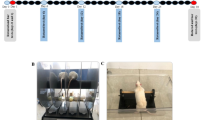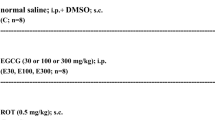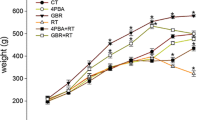Abstract
The present study aimed to investigate betanin’s neuroprotective effect in mice with rotenone-induced Parkinson-like motor dysfunction and neurodegeneration. Forty male ICR mice were divided into 4 groups: Sham-veh, Rot-veh, Rot-Bet100 and Rot-Bet200. Rotenone at 2.5 mg/kg/48 h was subcutaneous injected in Rot groups, and betanin at 100 and 200 mg/kg/48 h were given alternately with the rotenone injections in Bet groups for 6 weeks. Motor dysfunctions were evaluated weekly using hanging wire and rotarod tests. Brain oxidative status including malondialdehyde, reduced glutathione, catalase, superoxide dismutase, with neuronal degeneration in the motor cortex, striatum and substantia nigra par compacta were evaluated. The immunohistochemical densities of tyrosine hydroxylase in striatum and in substantia nigra par compacta were also measured. We found that rotenone significantly decreased the time to fall in a hanging wire test after the 4th week and after the rotarod test at the 6th week (p < 0.05). The percentage of neuronal degeneration in substantia nigra par compacta, striatum and motor cortex significantly increased (p < 0.05), and the tyrosine hydroxylase density in substantia nigra par compacta and in striatum significantly decreased (p < 0.05). Betanin at 100 and 200 mg/kg significantly prevented substantia nigra par compacta, striatum and motor cortex neuronal degeneration (p < 0.05) and maintained tyrosine hydroxylase density in substantia nigra par compacta and in striatum (p < 0.05). These findings appeared concurrently with improved effects on the time to fall in hanging wire and rotarod tests (p < 0.05). Treatment with betanin significantly prevented increased malondialdehyde levels and boosted reduced glutathione, catalase and superoxide dismutase activities (p < 0.05). Betanin exhibits neuroprotective effects against rotenone-induced Parkinson in mice regarding both motor dysfunction and neurodegeneration. Betanin’s neurohealth benefit relates to its powerful antioxidative property. Therefore, betanin use in neurodegenerative disease is interesting to study.







Similar content being viewed by others
Data availability
Available upon request.
References
Aartsma-Rus A, van Putten M (2014) Assessing functional performance in the mdx mouse model. J Vis Exp 27;(85):51303. https://doi.org/10.3791/51303
Abdel-Salam OOE, Youness E, Khadrawy Y, Mohammed N, Sleem A (2014) Rotenone-induced nigrostriatal toxicity is reduced by methylene blue. Journal of Neurorestoratology 2014:65–80
Ahmadi H, Nayeri Z, Minuchehr Z, Sabouni F, Mohammadi M (2020) Betanin purification from red beetroots and evaluation of its anti-oxidant and anti-inflammatory activity on LPS-activated microglial cells. PLoS ONE 15:e0233088. https://doi.org/10.1371/journal.pone.0233088
Allegra M, Tesoriere L, Livrea MA (2007) Betanin inhibits the myeloperoxidase/nitrite-induced oxidation of human low-density lipoproteins. Free Radic Res 41:335–341. https://doi.org/10.1080/10715760601038783
Callizot N, Combes M, Henriques A, Poindron P (2019) Necrosis, apoptosis, necroptosis, three modes of action of dopaminergic neuron neurotoxins. PLoS ONE 14:e0215277. https://doi.org/10.1371/journal.pone.0215277
Cannon JR, Tapias V, Na HM, Honick AS, Drolet RE, Greenamyre JT (2009) A highly reproducible rotenone model of Parkinson’s disease. Neurobiol Dis 34:279–290. https://doi.org/10.1016/j.nbd.2009.01.016
Crutchfield KC, Dluzen DE (2006) Rotenone produces opposite effects upon mouse striatal dopamine function as a result of environmental temperature. Neurotox Res 9:15–21. https://doi.org/10.1007/BF03033303
Davie CA (2008) A review of Parkinson’s disease. Br Med Bull 86:109–127. https://doi.org/10.1093/bmb/ldn013
Esatbeyoglu T, Wagner AE, Schini-Kerth VB, Rimbach G (2015) Betanin–a food colorant with biological activity. Mol Nutr Food Res 59:36–47. https://doi.org/10.1002/mnfr.201400484
Gambino G, Allegra M, Sardo P, Attanzio A, Tesoriere L, Livrea MA, Ferraro G, Carletti F (2018) Brain Distribution and Modulation of Neuronal Excitability by Indicaxanthin From Opuntia Ficus Indica Administered at Nutritionally-Relevant Amounts. Front. Aging Neurosci 10 (133). doi:https://doi.org/10.3389/fnagi.2018.00133
Guo JD, Zhao X, Li Y, Li GR, Liu XL (2018) Damage to dopaminergic neurons by oxidative stress in Parkinson’s disease (Review). Int J Mol Med 41:1817–1825. https://doi.org/10.3892/ijmm.2018.3406
Hadipour E, Fereidoni M, Tayarani-Najaran Z (2020) Betanin Attenuates Oxidative Stress Induced by 6-OHDA in PC12 Cells via SAPK/JNK and PI3 K Pathways. Neurochem Res 45:395–403. https://doi.org/10.1007/s11064-019-02927-w
Hasan W, Kori RK, Jain J, Yadav RS, Jat D (2020) Neuroprotective effects of mitochondria-targeted curcumin against rotenone-induced oxidative damage in cerebellum of mice. J Biochem Mol Toxicol 34:e22416. https://doi.org/10.1002/jbt.22416
Inden M, Kitamura Y, Abe M, Tamaki A, Takata K, Taniguchi T (2011) Parkinsonian rotenone mouse model: reevaluation of long-term administration of rotenone in C57BL/6 mice. Biol Pharm Bull 34:92–96. https://doi.org/10.1248/bpb.34.92
Indumathi D, Sujithra K, Srinivasan S, Vinothkumar V (2018) Betanin exhibits significant potential as an antihyperglycemic and attenuating the glycoprotein components in streptozotocin-nicotinamide-induced experimental rats. Toxicol Mech Methods 28:547–554. https://doi.org/10.1080/15376516.2018.1471636
Krajka-Kuzniak V, Paluszczak J, Szaefer H, Baer-Dubowska W (2013) Betanin, a beetroot component, induces nuclear factor erythroid-2-related factor 2-mediated expression of detoxifying/antioxidant enzymes in human liver cell lines. Br J Nutr 110:2138–2149. https://doi.org/10.1017/S0007114513001645
Lowry OH, Rosebrough NJ, Farr AL, Randall RJ (1951) Protein measurement with the Folin phenol reagent. J Biol Chem 193(1):265–275
Paxinos G, Franklin K (2008) The Mouse Brain in Stereotaxic Coordinates. 3 edn.
Rahimi P, Abedimanesh S, Mesbah-Namin SA, Ostadrahimi A (2019) Betalains, the nature-inspired pigments, in health and diseases. Crit Rev Food Sci Nutr 59(18):2949–2978. https://doi.org/10.1080/10408398.2018.1479830
Rahimmi A, Khosrobakhsh F, Izadpanah E, Moloudi MR, Hassanzadeh K (2015) N-acetylcysteine prevents rotenone-induced Parkinson’s disease in rat: An investigation into the interaction of parkin and Drp1 proteins. Brain Res Bull 113:34–40. https://doi.org/10.1016/j.brainresbull.2015.02.007
Richter F, Hamann M, Richter A (2007) Chronic rotenone treatment induces behavioral effects but no pathological signs of parkinsonism in mice. J Neurosci Res 85:681–691. https://doi.org/10.1002/jnr.21159
Sakamula R, Thong-Asa W (2018) Neuroprotective effect of p-coumaric acid in mice with cerebral ischemia reperfusion injuries. Metab Brain Dis 33:765–773. https://doi.org/10.1007/s11011-018-0185-7
Somredngan S, Thong-Asa W (2018) Neurological Changes in Vulnerable Brain Areas of Chronic Cerebral Hypoperfusion Mice. Ann Neurosci 24:233–242. https://doi.org/10.1159/000481789
Terron A, Bal-Price A, Paini A, Monnet-Tschudi F, Bennekou SH; EFSA WG EPI1 Members, Leist M, Schildknecht S (2018) An adverse outcome pathway for parkinsonian motor deficits associated with mitochondrial complex I inhibition. Arch Toxicol 92:41-82. https://doi.org/10.1007/s00204-017-2133-4
Thong-Asa W, Prasartsri S, Klomkleaw N, Thongwan N (2020) The neuroprotective effect of betanin in trimethyltin-induced neurodegeneration in mice. Metab Brain Dis 35:1395–1405. https://doi.org/10.1007/s11011-020-00615-1
Tural K, Ozden O, Bilgi Z, Kubat E, Ermutlu CS, Merhan O, Tasoglu I (2020) The protective effect of betanin and copper on spinal cord ischemia-reperfusion injury. J Spinal Cord Med:1–7. https://doi.org/10.1080/10790268.2020.1737788
Weihe E, Depboylu C, Schütz B, Schäfer MK, Eiden LE (2006) Three types of tyrosine hydroxylase-positive CNS neurons distinguished by dopa decarboxylase and VMAT2 co-expression. Cell Mol Neurobiol 26:659–678. https://doi.org/10.1007/s10571-006-9053-9
Zeng XS, Geng WS, Jia JJ (2018) Neurotoxin-Induced Animal Models of Parkinson Disease: Pathogenic Mechanism and Assessment. ASN Neuro 10:1759091418777438. https://doi.org/10.1177/1759091418777438
Zhang Q, Pan J, Wang Y, Lubet R, You M (2013) Beetroot red (betanin) inhibits vinyl carbamate- and benzo(a)pyrene-induced lung tumorigenesis through apoptosis. Mol Carcinog 52:686–691. https://doi.org/10.1002/mc.21907
Zhang ZN et al (2017) Subcutaneous rotenone rat model of Parkinson’s disease: Dose exploration study. Brain Res 1655:104–113. https://doi.org/10.1016/j.brainres.2016.11.020
Acknowledgements
We thank the Department of Zoology and the Faculty of Science, Kasetsart University.
Funding
This study was funded by Department of Zoology and the Faculty of Science (Student Research Project), Kasetsart University.
Author information
Authors and Affiliations
Contributions
Wachiryah Thong-asa conceived and designed research, analyzed data and wrote the manuscript. Sujira Jedsadavitayakol and Suchawalee Jutarattananon conducted experiments. All authors read and approved the manuscript for publication.
Corresponding author
Ethics declarations
Ethics approval
“All applicable international and national guidelines for the care and use of animals were followed”.
Consent to participate
All authors agree to participate.
Consent for publication
All authors agree to publish.
Conflict of interest
The authors declare that they have no conflict of interest.
Additional information
Publisher's note
Springer Nature remains neutral with regard to jurisdictional claims in published maps and institutional affiliations.
Rights and permissions
About this article
Cite this article
Thong-asa, W., Jedsadavitayakol, S. & Jutarattananon, S. Benefits of betanin in rotenone-induced Parkinson mice. Metab Brain Dis 36, 2567–2577 (2021). https://doi.org/10.1007/s11011-021-00826-0
Received:
Accepted:
Published:
Issue Date:
DOI: https://doi.org/10.1007/s11011-021-00826-0




